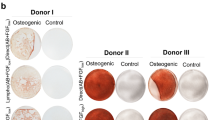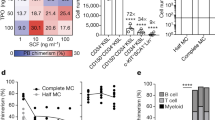Abstract
Bone marrow aspirates are composed of two cellular compartments, an abundant buffy coat suspension and a minor particulate fraction. The particulate fraction is routinely removed by filtration prior to transplantation in order to reduce the risk of embolism. This study shows that the filter-retained fraction includes many multicellular complexes, previously defined as haematons. A haematon is a finely arborized stromal-web which is tightly packed with haemopoietic progenitor cells and differentiated postmitotic cells. Comparison of the pooled buffy coat and the filter-retained materials from healthy donors showed that the haematon fraction contained 8–40 × 106 CD34+ cells, 20–115 × 103 high proliferative potential colony-forming cells (HPP-CFC) and 0.49–2.67 × 106 granulocyte–macrophage colony-forming unit (GM-CFU) which constituted 24 ± 8% (10–36; n = 8) of the total GM-CFU population harvested. Similar, but more variable recoveries of GM-CFU were obtained from the haematon fractions from patients with breast cancer (21 ± 13%; n = 10), Hodgkin’s disease (33 ± 19%; n = 4), non-Hodgkin’s lymphoma (21 ± 18; n = 7), but the recovery was lower from patients with acute myelogenous leukaemia (AML) (13 ± 13%; n = 6). The haematon fraction was enriched in CD34+ cells (2.5-fold), long-term culture initiating cells (LTC-IC/CAFC, week 5) (3.5-fold), HPP-CFC (2.8-fold) and GM-CFU (2.3-fold) over the buffy coat. Purified CD34+ cells expanded exponentially and produced 800 to 4000-fold more nucleated cells, 300 to 3500-fold more GM-CFU and 10 to 80-fold more HPP-CFC in stroma-free suspension culture with interleukin-1 (IL-1β), IL-3, IL-6, GM-CSF and stem cell factor (SCF), than did the starting cell input. The haematon fraction produced significantly more progenitor cells than the buffy coat in long-term liquid culture (LTC). This was due to the higher frequency of LTC-IC/CAFC and to the presence of the whole spectrum of native, stroma cell-associated CAFC in haematons. Thus, the haematon includes the most productive haematogenous compartment in human BM. This simple enrichment strategy, using filter-retained haematons, provides a rational source of BM cells for large scale experimental and/or clinical studies on haemopoietic stem cells and on critical accessory stromal cells.
This is a preview of subscription content, access via your institution
Access options
Subscribe to this journal
Receive 12 print issues and online access
$259.00 per year
only $21.58 per issue
Buy this article
- Purchase on Springer Link
- Instant access to full article PDF
Prices may be subject to local taxes which are calculated during checkout
Similar content being viewed by others
Author information
Authors and Affiliations
Rights and permissions
About this article
Cite this article
Blazsek, I., Marsalet, B., Legras, S. et al. Large scale recovery and characterization of stromal cell-associated primitive haemopoietic progenitor cells from filter-retained human bone marrow. Bone Marrow Transplant 23, 647–657 (1999). https://doi.org/10.1038/sj.bmt.1701616
Received:
Accepted:
Published:
Issue Date:
DOI: https://doi.org/10.1038/sj.bmt.1701616
Keywords
This article is cited by
-
Recreating the hematon: microfabrication of artificial haematopoietic stem cell microniches in vitro using dielectrophoresis
Biomedical Microdevices (2009)
-
Progenitor cells trapped in marrow filters can reduce GvHD and transplant mortality
Bone Marrow Transplantation (2006)
-
Preferential expression of the vasoactive intestinal peptide (VIP) receptor VPAC1 in human cord blood-derived CD34+CD38− cells: possible role of VIP as a growth-promoting factor for hematopoietic stem/progenitor cells
Leukemia (2004)



